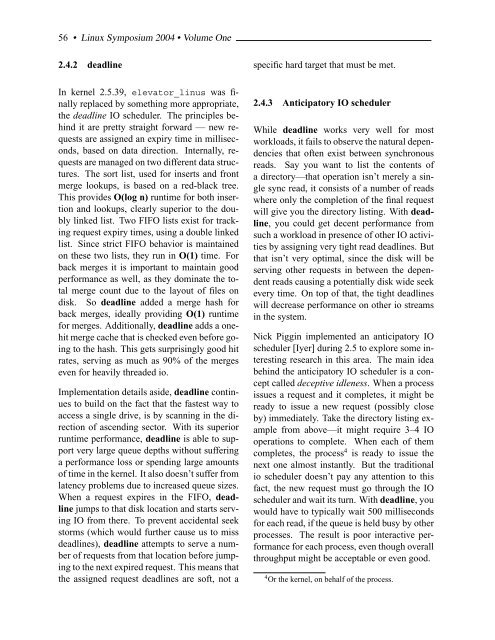You also want an ePaper? Increase the reach of your titles
YUMPU automatically turns print PDFs into web optimized ePapers that Google loves.
56 • <strong>Linux</strong> Symposium 2004 • Volume <strong>One</strong><br />
2.4.2 deadline<br />
specific hard target that must be met.<br />
In kernel 2.5.39, elevator_linus was finally<br />
replaced by something more appropriate,<br />
the deadline IO scheduler. <strong>The</strong> principles behind<br />
it are pretty straight forward — new requests<br />
are assigned an expiry time in milliseconds,<br />
based on data direction. Internally, requests<br />
are managed on two different data structures.<br />
<strong>The</strong> sort list, used for inserts and front<br />
merge lookups, is based on a red-black tree.<br />
This provides O(log n) runtime for both insertion<br />
and lookups, clearly superior to the doubly<br />
linked list. Two FIFO lists exist for tracking<br />
request expiry times, using a double linked<br />
list. Since strict FIFO behavior is maintained<br />
on these two lists, they run in O(1) time. For<br />
back merges it is important to maintain good<br />
performance as well, as they dominate the total<br />
merge count due to the layout of files on<br />
disk. So deadline added a merge hash for<br />
back merges, ideally providing O(1) runtime<br />
for merges. Additionally, deadline adds a onehit<br />
merge cache that is checked even before going<br />
to the hash. This gets surprisingly good hit<br />
rates, serving as much as 90% of the merges<br />
even for heavily threaded io.<br />
Implementation details aside, deadline continues<br />
to build on the fact that the fastest way to<br />
access a single drive, is by scanning in the direction<br />
of ascending sector. With its superior<br />
runtime performance, deadline is able to support<br />
very large queue depths without suffering<br />
a performance loss or spending large amounts<br />
of time in the kernel. It also doesn’t suffer from<br />
latency problems due to increased queue sizes.<br />
When a request expires in the FIFO, deadline<br />
jumps to that disk location and starts serving<br />
IO from there. To prevent accidental seek<br />
storms (which would further cause us to miss<br />
deadlines), deadline attempts to serve a number<br />
of requests from that location before jumping<br />
to the next expired request. This means that<br />
the assigned request deadlines are soft, not a<br />
2.4.3 Anticipatory IO scheduler<br />
While deadline works very well for most<br />
workloads, it fails to observe the natural dependencies<br />
that often exist between synchronous<br />
reads. Say you want to list the contents of<br />
a directory—that operation isn’t merely a single<br />
sync read, it consists of a number of reads<br />
where only the completion of the final request<br />
will give you the directory listing. With deadline,<br />
you could get decent performance from<br />
such a workload in presence of other IO activities<br />
by assigning very tight read deadlines. But<br />
that isn’t very optimal, since the disk will be<br />
serving other requests in between the dependent<br />
reads causing a potentially disk wide seek<br />
every time. On top of that, the tight deadlines<br />
will decrease performance on other io streams<br />
in the system.<br />
Nick Piggin implemented an anticipatory IO<br />
scheduler [Iyer] during 2.5 to explore some interesting<br />
research in this area. <strong>The</strong> main idea<br />
behind the anticipatory IO scheduler is a concept<br />
called deceptive idleness. When a process<br />
issues a request and it completes, it might be<br />
ready to issue a new request (possibly close<br />
by) immediately. Take the directory listing example<br />
from above—it might require 3–4 IO<br />
operations to complete. When each of them<br />
completes, the process 4 is ready to issue the<br />
next one almost instantly. But the traditional<br />
io scheduler doesn’t pay any attention to this<br />
fact, the new request must go through the IO<br />
scheduler and wait its turn. With deadline, you<br />
would have to typically wait 500 milliseconds<br />
for each read, if the queue is held busy by other<br />
processes. <strong>The</strong> result is poor interactive performance<br />
for each process, even though overall<br />
throughput might be acceptable or even good.<br />
4 Or the kernel, on behalf of the process.

















